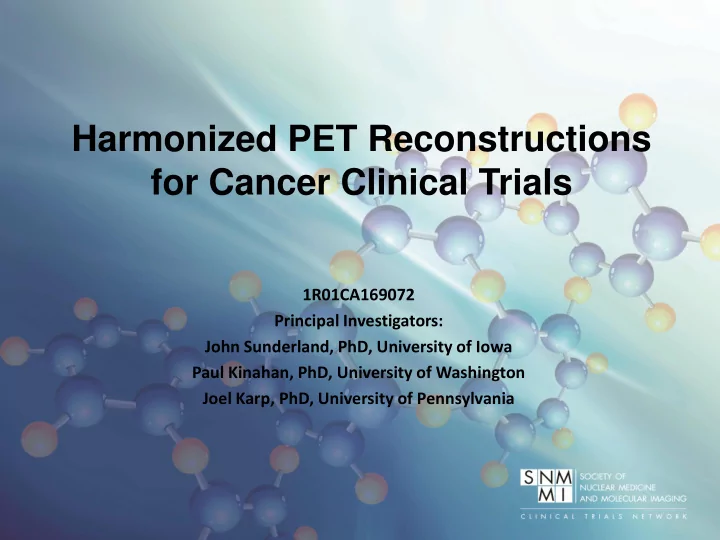

Harmonized PET Reconstructions for Cancer Clinical Trials 1R01CA169072 Principal Investigators: John Sunderland, PhD, University of Iowa Paul Kinahan, PhD, University of Washington Joel Karp, PhD, University of Pennsylvania
PET Imaging in Cancer Clinical Trials Clinicaltrials.go v identifier Sponsor Endpoint Imaging Endpoint Title A Phase II Trial of GW572016 For Brain [18F]FDG-PET metabolic Metastases in Patients with HER2-Positive NCT00098605 GSK Secondary response Breast Cancer Lapatinib In Combination With Trastuzumab [18F]FDG-PET metabolic Versus Lapatinib Monotherapy In Subjects With NCT00320385 GSK Secondary response HER2-positive Metastatic Breast Cancer Exploratory Lapatinib (Positron Emission Tomography) PET Study in Subjects With Breast NCT01290354 GSK Primary [11C]Lapatinib-PET PK Cancer [18F]FLT-PET proliferative A Pilot Study Of PD-0332991 In Patients With NCT00420056 Pfizer Primary response Previously Treated Mantle Cell Lymphoma [18F]FDG-PET metabolic Regorafenib in Patients With Metastatic and/or NCT01068769 Bayer Secondary response Unresectable Gastrointestinal Stromal Tumor The Use of RAD001 With Docetaxel in the [18F]FDG-PET metabolic Treatment of Metastatic, Androgen NCT00459186 Novartis Secondary response Independent Prostate Cancer [18F]FDG-PET metabolic Bevacizumab Plus Ipilimumab in Patients With NCT00790010 Novartis Secondary response Unresectable Stage III or IV Melanoma PET imaging is inherently quantitative, [18F]FDG-PET metabolic A Phase 1 Study of BMS-833923 (XL139) in NCT00670189 BMS Exploratory response Subjects With Advanced or Metastatic Cancer and well suited for use in cancer clinical Neoadjuvant and Adjuvant Imatinib Mesylate trials with imaging endpoints . [18F]FDG-PET metabolic in Treating Patients With Primary or Recurrent NCT00028002 NCI Secondary response Malignant Gastrointestinal Stromal Tumor [18F]FDG-PET metabolic Linsitinib To Treat Patients With NCT01560260 NCI, SARC Secondary response Gastrointestinal Stromal Tumors 2
Harmonized PET Reconstructions for Cancer Clinical Trials Challenges: o Substantial variability in PET image quantitative accuracy hampers it use in multi-center trials This signal source size- and PET scanner-dependent variability o Degrades the quality of clinical trials by requiring more patient accrual (to reach statistical significance in clinical trials) o Leads to inconclusive results in tests of badly needed cancer therapies 3
Impact of Different Reconstructions on Objects of Different Sizes 4
Impact of Quantitative Variability on Sample Size in Clinical Trials test power of 80% and significance level (α) = 0.05 Reducing inter-scanner reconstruction and calibration variability (Goals of the grant) by 10% (for example from 30% to 20%) can lead to a decrease in necessary sample size of a factor of two or more in a clinical trial. Kinahan, P.E., et al., PET/CT Assessment of Response to Therapy: Tumor Change Measurement, Truth 5 Data, and Error. Transl Oncol, 2009. 2(4): p. 223-30. …project overview
Project Overview o Designed to reduce quantitative variability of PET image data in clinical trials through identification and verification of quantitatively harmonized reconstructions. o True Academic industrial partnership with o Industry scientists as true co-investigators (funded by industry) o Management buy-in to implement results of project in commercial product (if successful) o Long-term project sustainability through built-in engagement of professional organizations and societies. o SNMMI/CTN, RSNA/QIBA 6
Industry and Society Involvement The Clinical Trials Network (CTN) of the SNMMI is coordinating the project, providing administrative support for the considerable logistics, and contributing necessary image server and software infrastructure. GE, Philips, and Siemens are each contributing access to their physics and engineering leadership for scientific collaboration, while also contributing personnel and hardware infrastructure necessary to perform the controlled image reconstructions for the project. NIST is providing expertise associated with the 68 Ge- 68 Ga NIST traceable sources used in this project. Rad-Qual is manufacturing the NIST traceable sources used in this project. EANM Research Limited (EARL) is collaborating to assure that harmonization efforts associated with this project are performed as much in concert with parallel efforts by EANM as possible. RSNA and its QIBA initiative and association with ACR’s ACRIN provide a long - term sustainability mechanism for project results 7
Industry Buy-In o Top PET imaging scientists from Siemens, GE and Philips to help with identifying make and model specific reconstruction parameters to be harmonized to result in PET images quantitatively identical to one another for use in clinical trials. o The Industry Partners have agreed that pursuit of identification of make and model specific harmonized reconstruction parameters to use only in clinical trials is a non-competitive space in which direct involvement is globally beneficial to the molecular imaging field. o Vendor scientists are actively engaged in this project. They are responsible for: – Performing version controlled reconstructions (from acquisition date Very specific commitments and provided from academic sites) for all of their scanner models for the project action plans from industry partners – Providing scientific guidance on the project – Industry scientists are full partners in this project. 8 …research approach
Research Approach - STEP 1: Scanner Model Identification 1. Identify (with help of vendors) all recent and current make and model PET/CT scanners (currently 13) 9
Research Approach - STEP 2: Phantom Imaging 10
Research Approach - STEP 3: Data Analysis Biograph 40 4I-8S-7FWHM Activity at Hot Spot /ActuaActivity 120% 100% 100% 80% 60% Max 40% Reference 20% 0% 0 10 20 30 40 Sphere Inner Diameter 3) Generate Recovery Coefficient Curves for spheres of different sizes for each scanner, and over a broad range of reconstruction parameters 11
Research Approach - STEP 4: Harmonization Regions Identification 4) Identify harmonizable regions in the set of Recovery Coefficient curves into which all subsequent harmonized reconstructions will reside. 12 …take home
Harmonized PET Reconstructions for Cancer Clinical Trials Take Home Message • Potential for significant improvement to multicenter cancer clinical trials • Wide and specific participation by industry and research communities, planning for long term sustainability • Potential implication in addressing Big Data challenges 13
Recommend
More recommend